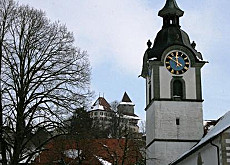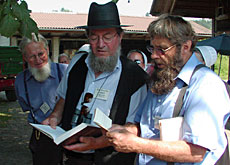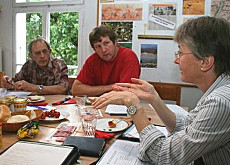“No one possesses the truth”

One of Switzerland's oldest yet nearly forgotten Protestant churches has been thrust into the spotlight this year and is trying to come to terms with its new role.
A visit to the Jura hills where small Mennonite communities survived centuries of persecution reveals the challenge members of this church face today in escaping the shadows of the past.
The decision by the authorities of canton Bern to support the commemorative events of Anabaptist Year 2007 was bold since it puts the accent on the injustices done by their predecessors to Anabaptists – who are mainly known as Mennonites today.
Among the highlights are historical exhibitions on the most radical wing of the Reformation, plays, presentations, an international gathering and tours of the two Swiss regions where Anabaptism once flourished – the Emmental and the Jura.
There has already been a huge interest in visits to Anabaptist sights in the western Jura heights, according to retired Mennonite farmer and amateur historian, Pierre Zürcher.
And what sets the visitors apart this year, Zürcher says, is that they are not North American Mennonites or Amish wishing to learn about the hard life of their ancestors, but people from Switzerland’s recognised Protestant church.
They, like swissinfo, are shown the few crumbling remains of the “Anabaptist Bridge” which once crossed a verdant gorge. It was here that followers of the faith gathered in secret to hold worship services. The spiritual tranquillity of the place is still undeniable.
It was to the Jura, France’s Alsace region and Germany’s Rhineland-Palatinate that the Anabaptists first fled since their establishments tolerated the Anabaptists’ unshakeable belief in adult instead of infant baptism as well as in the separation of church and state.
Fearful
Reflecting upon his own memories, Zürcher says Mennonites within his congregation remained so fearful of persecution that they refused to allow a membership list to be drawn up until the 1970s.
The Jeangui chapel on the other side of the valley houses a small exhibition detailing Anabaptist history and a priceless collection of rare books and documents including a Froschauer bible, which predated Luther’s translation by a few years.
A family tree also on display clearly illustrates just how few of Zürcher’s 18th century ancestors resisted the urge to emigrate to North America. Indeed, of the 1.5 million Mennonites worldwide today, only 2,500 Mennonites are in Switzerland.
And Swiss Mennonite congregations do not stand out as some free churches do with controversial positions on issues such as creationism, or through proselytising.
As members of the Mennonite World Conference, they share common beliefs such as renouncing violence and being committed to their communities through charity work.
Fourteen congregations now belong to the Swiss Mennonite Conference, and mutual business is discussed every few weeks by the umbrella group’s executive council.
In season
Fruit ripe for picking weighs down the branches of the cherry tree visible through the open window and birdsong accompanies the talks inside the meetinghouse in Brügg near Biel, a village at the foot of the Jura hills. It may have taken centuries, but the season has finally come for Switzerland’s Mennonites.
While the business being discussed is routine – exchange programmes, insurance for missionaries, leadership of the youth organisation – there is an openness to talk to swissinfo about the meaning of the commemorative year for the church.
“We’re no longer being ignored but have become a popular dialogue partner,” explains Erwin Röthlisberger from the Bern congregation. “It’s quite special for me personally to be invited by the recognised Protestant church to give a speech about Anabaptism and to take part in their worship service, which would have been out of the question 20 years ago.”
Abortion
But the Mennonite message on contemporary issues such as abortion and same-sex marriages is often confused. “We are in danger of having very different opinions on [controversial subjects] and our challenge is to still be able to talk to one another,” interjects Paul Gerber, who is conference president and represents the Jura communities.
“Our position is that no one possesses the truth,” adds Madeleine Bähler from Basel. “The Bible was laid out to one and all by the Holy Ghost and therefore we have to live with the fact that there are many interpretations. We don’t expect that there is someone above us [in the church] who has the last word.”
Daniel Geiser, also from the Jura, points out that the movement’s impact has not just been felt in recent months but has been quietly influencing other Protestant churches for some time.
“Very few of them practiced adult baptism 100 years ago, but most free churches support it now and that’s crucial,” Geiser concludes. “It’s very positive.”
swissinfo, Dale Bechtel in Sonceboz-Sombeval and Brügg
In 1525, former associates of Ulrich Zwingli began to baptise adults, and these “Swiss brethren” as they became known rejected the new reformed church and founded congregations independent of the state.
Similar movements soon developed across western Europe. Followers, who would be called Mennonites after Menno Simmons, an Anabaptist leader from the Netherlands, were persecuted for refusing to participate in the state-run church.
Internal divisions led a radical faction, the Amish, to split in 1693. Members took their name from Anabaptist leader Jakob Ammann, who came from canton Bern’s Simmental valley.
There are believed to be around 600,000 descendants of Swiss Anabaptists living in North America.
The Mennonite community in Switzerland today has 2,500 members belonging to 14 congregations.
As part of Anabaptist Year, events are being held throughout canton Bern and other parts of northwestern Switzerland to remember the persecution of members of the movement.
Important sights in the Jura region include the “Anabaptist Bridge” located in the hills above the village of Corgémont, and the archives kept in the Jeangui Chapel belonging to the Sonnenberg congregation.
Visitors from abroad are being encouraged to attend an international gathering in the Emmental from July 26-29.

In compliance with the JTI standards
More: SWI swissinfo.ch certified by the Journalism Trust Initiative




You can find an overview of ongoing debates with our journalists here. Please join us!
If you want to start a conversation about a topic raised in this article or want to report factual errors, email us at english@swissinfo.ch.